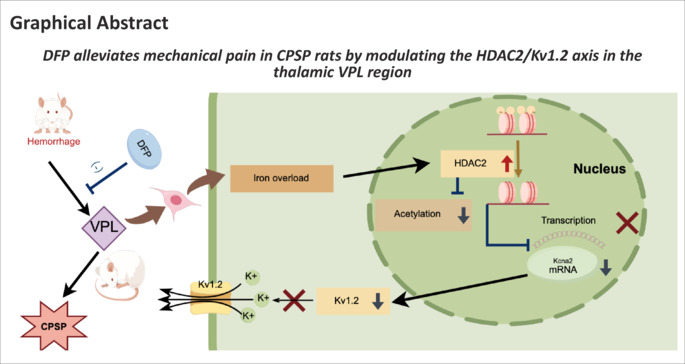- Record: found
- Abstract: found
- Article: found
Repressing iron overload ameliorates central post-stroke pain via the Hdac2-Kv1.2 axis in a rat model of hemorrhagic stroke

Read this article at
Abstract

Abstract
Thalamic hemorrhage can lead to the development of central post-stroke pain. Changes in histone acetylation levels, which are regulated by histone deacetylases, affect the excitability of neurons surrounding the hemorrhagic area. However, the regulatory mechanism of histone deacetylases in central post-stroke pain remains unclear. Here, we show that iron overload leads to an increase in histone deacetylase 2 expression in damaged ventral posterolateral nucleus neurons. Inhibiting this increase restored histone H3 acetylation in the Kcna2 promoter region of the voltage-dependent potassium (Kv) channel subunit gene in a rat model of central post-stroke pain, thereby increasing Kcna2 expression and relieving central pain. However, in the absence of nerve injury, increasing histone deacetylase 2 expression decreased Kcna2 expression, decreased Kv current, increased the excitability of neurons in the ventral posterolateral nucleus area, and led to neuropathic pain symptoms. Moreover, treatment with the iron chelator deferiprone effectively reduced iron overload in the ventral posterolateral nucleus after intracerebral hemorrhage, reversed histone deacetylase 2 upregulation and Kv1.2 downregulation, and alleviated mechanical hypersensitivity in central post-stroke pain rats. These results suggest that histone deacetylase 2 upregulation and Kv1.2 downregulation, mediated by iron overload, are important factors in central post-stroke pain pathogenesis and could serve as new targets for central post-stroke pain treatment.
Related collections
Most cited references89
- Record: found
- Abstract: found
- Article: not found
Heart Disease and Stroke Statistics—2021 Update: A Report From the American Heart Association
- Record: found
- Abstract: found
- Article: found
